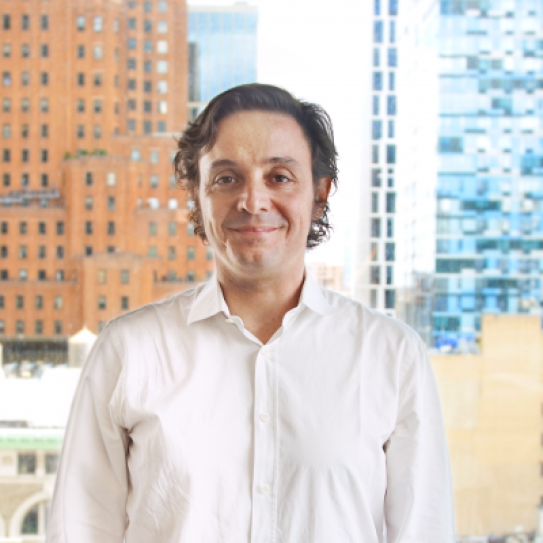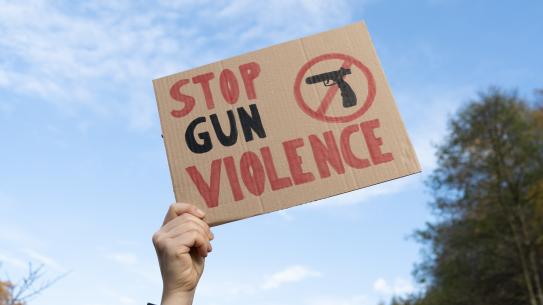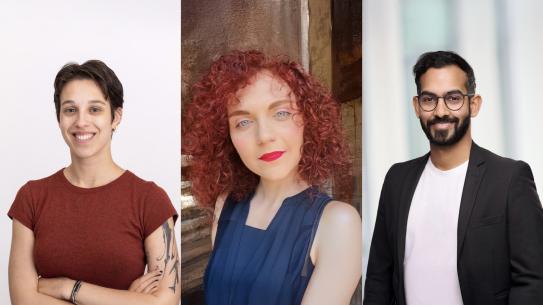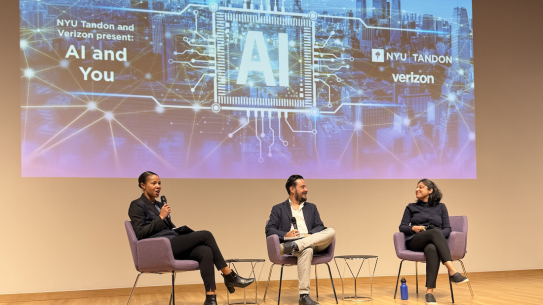Maurizio Porfiri
-
Civil and Urban Engineering Department Interim Chair
-
Institute Professor
-
Director of Center for Urban Science + Progress (CUSP)
-
Director of the Urban Institute

Dr. Maurizio Porfiri is an Institute Professor at New York University Tandon School of Engineering, with tenured appointments at the Departments of Mechanical and Aerospace Engineering and Biomedical Engineering. He is also the Director of the Center for Urban Science + Progress and Interim Chair of the Civil and Urban Engineering Department at NYU Tandon, as well as the inaugural Director of the Urban Institute. He received M.Sc. and Ph.D. degrees in Engineering Mechanics from Virginia Tech, in 2000 and 2006; a “Laurea” in Electrical Engineering (with honors) and a Ph.D. in Theoretical and Applied Mechanics from Sapienza University of Rome and the University of Toulon (dual degree program), in 2001 and 2005, respectively. He has been on the faculty of the Mechanical and Aerospace Engineering Department since 2006, when he founded the Dynamical Systems Laboratory.
Dr. Porfiri is a Fellow of the American Society of Mechanical Engineers (ASME) and the Institute of Electrical and Electronic Engineers (IEEE). He has served in the Editorial Board of ASME Journal of Dynamics systems, Measurements and Control, ASME Journal of Vibrations and Acoustics, Flow: Applications of Fluid Mechanics, IEEE Control Systems Letters, IEEE Transactions on Circuits and Systems I, IEEE Transactions on Network Science and Engineering, Mathematics in Engineering, and Mechatronics. Dr. Porfiri is engaged in conducting and supervising research on complex systems, with applications from mechanics to behavior, public health, and robotics.
He is the author of approximately 400 journal publications, including papers in Nature, Nature Human Behaviour, and Physical Review Letters. He was included in the “Brilliant 10” list of Popular Science in 2010 and his research featured in major media outlets, such as CNN, NPR, Scientific American, and Discovery Channel. Other significant recognitions include National Science Foundation CAREER award; invitations to the Frontiers of Engineering Symposium and the Japan-America Frontiers of Engineering Symposium organized by National Academy of Engineering; invitation to the third and fourth World Laureate Forums; the Outstanding Young Alumnus award by the college of Engineering of Virginia Tech; the ASME Gary Anderson Early Achievement Award; the ASME DSCD Young Investigator Award; the ASME C.D. Mote, Jr. Early Career Award; and the Research Excellence Award from New York University Tandon School of Engineering.
Education
Sapienza University of Rome, 2001
Laurea (B.Sc./M.Sc.), Electrical Engineering
Sapienza University of Rome, 2005
Doctor of Philosophy, Theoretical and Applied Mechanics
Virginia Polytechnic Institute & State University, 2000
Master of Science, Engineering Mechanics
University of Toulon, 2005
Doctor of Philosophy, Theoretical and Applied Mechanics
Virginia Polytechnic Institute & State University, 2006
Doctor of Philosophy, Engineering Mechanics
Experience
NYU Tandon School of Engineering
Institute Professor
From: January 2020 to present
NYU Tandon School of Engineering
Professor
From: September 2014 to present
NYU Tandon School of Engineering
Associate Professor
From: September 2011 to August 2014
NYU Tandon School of Engineering
Assistant Professor
From: July 2006 to September 2011
Virginia Polytechnic Institute and State University
Post-Doctoral Associate
From: July 2005 to June 2006
Publications
Journal Articles (selection from the last ten years)
- Porfiri, M., 2020: "Validity and limitations of the detection matrix to determine hidden units and network size from perceptible dynamics", Physical Review Letters 124(16), 168301
- Porfiri, M., Sattanapalle, R. R., Nakayama, S., Macinko, J., Sipahi, R., 2019: "Media coverage and firearm acquisition in the aftermath of a mass shooting", Nature Human Behaviour 3(9), 913-921
- Zhang, P., Rosen, M., Peterson, S. D., Porfiri, M., 2018: "An information-theoretic approach to study fluid-structure interactions",Journal of Fluid Mechanics 848, 968-986
- Golovneva, O., Jeter, R., Belykh, I., Porfiri, M., 2017: "Windows of opportunity for synchronization in stochastically coupled maps",Physica D: Nonlinear Phenomena 340, 1-13
- Zino, L., Rizzo, A., Porfiri, M., 2016: "Continuous-time discrete-distribution theory for activity-driven networks", Physical Review Letters 117(22), 228302
- Mwaffo, V., Anderson, R. P., Butail, S., Porfiri, M., 2015: "A jump persistent turning walker to model zebrafish locomotion", Journal of the Royal Society Interface 12(102), 20140884
- Cha, Y., Porfiri, M., 2014: "Mechanics and electrochemistry of ionic polymer metal composites", Journal of the Mechanics and Physics of Solids 71, 156–178
- Panciroli, R., Porfiri, M., 2013: "Evaluation of the pressure field on a rigid body entering a quiescent fluid through particle image velocimetry", Experiments in Fluids 54(12), 1630
- Marras, S., Porfiri, M., 2012: "Fish and robots swimming together: attraction towards the robot demands biomimetic locomotion", Journal of the Royal Society Interface 9(73), 1856–1868
- Abaid, N., Porfiri, M., 2011: "Consensus over numerosity-constrained random networks", IEEE Transactions on Automatic Control 56(3), 649-654
- Aureli, M., Kopman, V., Porfiri, M., 2010: "Free-locomotion of underwater vehicles actuated by ionic polymer metal composites",IEEE/ASME Transactions on Mechatronics 15(4), 603-614
Awards
- Institute Professor at NYU Tandon School of Engineering, 2020
- ASME Fellow, 2019
- IEEE Fellow, Control Systems Society, 2019 ("For contributions to biomimetic robotics")
- ASME C.D. Mote, Jr. Early Career Award, 2015
- Invitee of Japan-America Frontiers of Engineering Symposium, National Academy of Engineering, 2014
- Jacobs Excellence in Education Award, 2014
- ASME Dynamic Systems & Control Division Young Investigator Award, 2013
- ASME Gary Anderson Early Achievement Award, 2013
- Outstanding Young Alumnus, College of Engineering Virginia Polytechnic Institute and State University, 2012
- Best student paper competition award at the 2012 ASME Conference on Smart Materials, Adaptive Structures and Intelligent Systems (with graduate students Youngsu Cha and Matteo Aureli)
- Invited speaker for the “lectio magistralis” at “Sapienza Ricerca”, 2011
- Best paper award at the 2011 ASME Dynamic Systems and Control Conference (with graduate student Nicole Abaid)
- Invitee of Frontiers of Engineering Symposium, National Academy of Engineering, 2011
- Jacobs Excellence in Education Award, 2011
- Popular Science "Brilliant Ten", 2010
- Best robotics paper award at the 2009 ASME Dynamic Systems and Control Conference (with graduate students Matteo Aureli and Vladislav Kopman)
- NSF Career award (Dynamical systems), 2008
- H2CU medal, 2008
Research News
NYU Tandon team help develop bio-inspired robotics for disaster response and construction, in new NSF-funded project
The United States recorded 28 natural disasters causing at least $1 billion in damages each in 2023, the highest number in the nation's history. Now researchers at NYU Tandon are helping develop a robotic system that could significantly reduce disaster recovery times while improving efficiency for contractors working in confined spaces.
Along with colleagues from New Jersey Institute of Technology, who led the project, and a researcher from The University of Scranton, the Tandon team led by Maurizio Porfiri and Semiha Ergan is part of a three-year, $5 million U.S. National Science Foundation (NSF)-funded project to create the Kastor robotic system. The funding comes from the NSF Directorate for Technology, Innovation and Partnerships, which supports research that brings together multiple disciplines and sectors to solve complex societal and operational challenges.
This Phase 2 award follows a previous $650,000 Phase 1 grant that developed a prototype robot and algorithms.
The Kastor robotic system uses swarms of self-assembling robots to transport equipment and clear debris in disaster zones, addressing a persistent challenge in disaster response: much of the workforce effort goes toward moving supplies and removing debris rather than critical tasks like searching for survivors.
The technology takes its design cues from fire ants and slime molds. Fire ants can link their bodies to form bridges over difficult terrain, while slime molds create efficient transport networks across varied surfaces. The Kastor system applies these biological strategies to create networks of flat metal robotic tiles that can autonomously reconfigure themselves as conditions change.
The tiles move themselves into position and use wheels and treads to transport pallets across disaster sites without human intervention. Algorithms developed by the research team guide their assembly and movement patterns.
Porfiri — who directs NYU's Center for Urban Science + Progress (CUSP) and is Institute Professor in the departments of Mechanical and Aerospace Engineering, Biomedical Engineering, and Civil and Urban Engineering (CUE) — brings expertise in urban science and virtual reality to the project. His role focuses on ensuring the technology integrates with existing disaster response workflows in urban environments.
Ergan — an associate professor in CUE, and on the faculty of CUSP, Institute of Design and Construction (IDC) Innovation Hub, and C2SMARTER transportation center — is leading virtual and on-site pilot studies that will test the system in realistic construction and recovery scenarios.
"Each community faces different challenges when disasters strike, and current response methods often require inefficient manual labor for debris removal and supply transport," Porfiri said. The project team has consulted with police officers, emergency responders, contractors and construction companies to understand operational requirements.
"We want to bring the high-tech automation of distribution facilities and smart warehouses to messy, unstructured outdoor environments," said Petras Swissler, an assistant professor of mechanical and industrial engineering at NJIT and the project's principal investigator.
Beyond disaster response, the researchers found the same challenges exist in construction projects, where efficiency improvements have lagged behind other industries.
"This technology will also assist at construction sites where space is tight and the ability to navigate in multiple directions while carrying dirt and construction materials is limited," Ergan said.
The project will develop a production-ready robotic system, create interfaces for operators to control the robot swarms, and conduct pilot studies in both disaster response and construction settings. Along with Porfiri and Ergan, the other co-principal investigators are Simon Garnier, a biology professor at NJIT, and Jason Graham, a mathematics professor at The University of Scranton.
New York City's medical specialist advantage may be an illusion, new NYU Tandon research shows
New York City offers nearly every type of medical specialist but provides fewer specialty healthcare providers per capita than smaller cities, according to a new study that challenges conventional assumptions about urban healthcare advantages and reveals a troubling paradox across America's largest metropolitan areas.
The research, published in Nature Cities, analyzed data from 1.4 million healthcare providers across 75 medical specialties in 898 metropolitan and micropolitan areas. The innovative approach combines urban scaling theory—which examines how city characteristics change with population size—with network science and economic geography to examine healthcare access in unprecedented detail.
Rather than treating healthcare as a single entity, the researchers examined each medical specialty separately, revealing that 88% exhibit what they call "sublinear scaling," meaning larger cities have proportionally fewer specialists per resident than smaller ones.
"We're discovering that the healthcare advantages of living in big cities may be an illusion when it comes to specialized care," explains lead researcher Maurizio Porfiri. "We all assume residents of large metropolitan areas have better access to healthcare than residents of smaller cities, but this is really true only for primary care services. Our findings suggest this assumption breaks down completely for medical specialists. A small city may not offer all the specialties of large cities, but in what it offers it may outperform them.”
Porfiri is an NYU Tandon Institute Professor with appointments in the Departments of Mechanical and Aerospace Engineering (MAE), Biomedical Engineering (BME), Civil and Urban Engineering (CUE), and Technology Management and Innovation (TMI). He also serves as Director of the NYU Center for Urban Science + Progress (CUSP).
The study represents the latest application of Porfiri's urban scaling methodology, which he has previously used to analyze gun violence patterns and the relationship between city living, ADHD and obesity. His research uses Scale-Adjusted Metropolitan Indicators (SAMIs) to control for population differences and reveal how cities deviate from expected patterns.
The study found that while cities like New York and Chicago offer nearly all examined specialties (NYC has 74 — missing only anesthesiology assistants — and Chicago has all 75), residents may face longer wait times and specialists higher patient loading.
In contrast, smaller cities may lack certain specialties entirely—73 of the 75 specialties showed significant associations between availability and population size—but those that exist serve fewer patients per provider. For example, Marshfield, Wisconsin provides 16.8 specialists per 1,000 residents compared to New York's 4.7 per 1,000.
Among the most underrepresented specialties in large cities per capita are addiction medicine, preventive medicine, osteopathic manipulative medicine, and micrographic dermatologic surgery.
Addiction medicine shows the starkest disparity, with large cities providing dramatically fewer specialists per resident than smaller areas. These fields showed the strongest sublinear scaling, meaning residents of major metropolitan areas have significantly fewer of these specialists available relative to their population size compared to smaller cities.
The research identifies two mechanisms driving this paradox: higher patient loads overwhelming specialists in large cities, and economic clustering that concentrates medical expertise in dense hospital networks, creating geographic inequalities.
“The findings have serious implications as the U.S. population ages. The study found sublinear scaling in geriatric specialties like urology and gerontology, suggesting major metropolitan areas may be unprepared for growing elderly populations,” said Tian Gan, a NYU Tandon mechanical engineering PhD student in the urban science track, and the paper’s lead author.
Geographic patterns reveal stark regional disparities. The highest specialist concentrations cluster in the Midwest—Minnesota alone claims two of the top five cities—while all five cities with the lowest access are in the South.
Not all specialties follow this pattern. Several key specialties—including anesthesiology, internal medicine, and clinical psychology—actually have more providers per capita in large cities, reflecting higher urban demand for these services.
The research provides a framework for understanding healthcare distribution that moves beyond the traditional urban-rural dichotomy. Rather than viewing cities as uniformly advantaged, policymakers must consider the complex interplay between diversity and provision of medical services.
Along with Porfiri and Gan, the paper's additional author is Tanisha Dighe, NYU Tandon MS student in applied urban science and information. The study was supported by National Science Foundation grants.
APPENDIX: Medical Specialist Availability by City
CITIES WITH THE MOST MEDICAL SPECIALISTS (Cities offering all specialty types)
- Chicago-Naperville-Elgin, IL-IN: 75 specialties
- Houstone-Pasadena-The Woodlands, TX: 75 specialties
- Atlanta-Sandy Springs-Roswell, GA: 75 specialties
- Washington-Arlington-Alexandria, DC-VA-MD-WV: 75 specialties
- Miami-Fort Lauderdale-West Palm Beach, FL: 75 specialties
CITIES WITH THE FEWEST MEDICAL SPECIALISTS (Fewest specialty types available)
- Monroe, LA: 5 specialties
- Zapata, TX: 6 specialties
- Raymondville, TX: 6 specialties
- Synder, TX: 11 specialties
- Andrews, TX: 11 specialties
CITIES WITH THE HIGHEST CONCENTRATION OF SPECIALISTS OVERALL (All non-primary-care specialists combined per 1,000 residents)
- Rochester, Minnesota: 21.1 specialists (home to Mayo Clinic)
- Marshfield, Wisconsin: 16.8 specialists
- Sunbury, Pennsylvania: 16.3 specialists
- Easton, Maryland: 15.7 specialists
- Albert Lea, Minnesota: 15.4 specialists
CITIES WITH THE LOWEST CONCENTRATION OF SPECIALISTS OVERALL (Fewest specialists per 1,000 residents)
- Monroe, Louisiana: 0.1 specialists
- Virginia Beach-Norfolk, Virginia: 0.4 specialists
- Danville, Virginia: 0.8 specialists
- Rio Grande City-Roma, Texas: 1.0 specialists
- Bonham, Texas: 1.0 specialists
SPECIALTIES MOST UNDERREPRESENTED IN MAJOR METROS, 1M+ POPULATION
(Scaling exponents - how fast they grow with population growth )
- Addiction Medicine (0.305) - Most underrepresented
- Preventive Medicine (0.331)
- Osteopathic Manipulative Medicine (0.351)
- Micrographic Dermatologic Surgery (0.379)
- Maxillofacial Surgery (0.398)
- Marriage and Family Therapist (0.400)
- Nuclear Medicine (0.408)
- Advanced Heart Failure and Transplant Cardiology (0.446)
- Certified Clinical Nurse Specialist (0.457)
- Sleep Medicine (0.457)
SPECIALTIES MOST OVERREPRESENTED IN MAJOR METROS
(Scaling exponents - - how fast they grow with population growth)
- Anesthesiology (1.154) - Most overrepresented
- Internal Medicine (1.100)
- Physical Therapy (1.089)
- Clinical Psychology (1.069)
- Physician Assistant (1.057)
- Obstetrics/Gynecology (1.050)
- Neurology (1.039)
- Psychiatry (1.031)
- Gastroenterology (1.022)
NYC SPECIALIST COUNTS (74 out of 75 research specialties)
Missing only: Anesthesiology Assistant
Top 10:
- Nurse Practitioner: 8,977
- Internal Medicine: 8,194
- Physical Therapy: 7,515
- Physician Assistant: 6,224
- Clinical Social Worker: 4,842
- Anesthesiology: 3,637
- Family Practice: 3,259
- Diagnostic Radiology: 2,843
- Emergency Medicine: 2,545
- Psychiatry: 2,465
Notable underrepresented specialties (bottom 5):
- Maxillofacial Surgery: 40
- Micrographic Dermatologic Surgery: 25
- Preventive Medicine: 21
- Marriage and Family Therapist: 18
- Addiction Medicine: 16
Gan, T., Dighe, T. & Porfiri, M. Trade-off between diversity and provision of specialized healthcare in US cities. Nat Cities (2025).
Sophisticated data analysis uncovers how city living disrupts ADHD's path to obesity
A hidden link between impulsivity and obesity may not be fixed in human biology but shaped by the cities we live in.
Using a novel engineering-based approach, researchers from NYU Tandon School of Engineering and Italy's Istituto Superiore di Sanità found that attention-deficit/hyperactivity disorder (ADHD) contributes to obesity not only directly through known biological pathways but also indirectly, by reducing physical activity. The findings are published in PLOS Complex Systems.
Obesity prevalence is also influenced by other city-level variables, such as access to mental health services and food insecurity, thereby opening the door to potential mitigation strategies.
To uncover the nexus between ADHD and obesity, the research team applied urban scaling laws — a mathematical framework from complexity science — to public health data from 915 U.S. cities. Urban scaling describes how features of cities change with population size, similar to how biological traits scale with body size.
They found that both ADHD and obesity decrease sublinearly with population: as cities grow, per-capita prevalence declines. Meanwhile, access to mental health providers and college education rises superlinearly, increasing faster than city size. Larger cities, it seems, offer not just more services, but disproportionately more support for conditions linked to impulsivity.
But size alone doesn’t tell the full story. To reveal where cities over- or underperform relative to expectations, the researchers used Scale-Adjusted Metropolitan Indicators (SAMIs). SAMIs measure how much a city deviates from what urban scaling would predict — highlighting, for example, when a small city has unusually low obesity rates or when a large one falls short on mental health access. These deviations became the foundation for a causal analysis.
"Urban scaling and causal discovery methods allow us to see relationships that traditional health research might miss," explains Maurizio Porfiri, senior author on the PLOS paper. Porfiri is an NYU Tandon Institute Professor with appointments in the Departments of Mechanical and Aerospace Engineering, Biomedical Engineering, Civil and Urban Engineering, and Technology Management and Innovation. He also serves as Director of the NYU Center for Urban Science + Progress (CUSP).
"Without accounting for how city size naturally affects health metrics, we’d misattribute success or failure to the wrong factors. By filtering out these population effects first, we can identify the true causal pathways linking ADHD to obesity — and more importantly, how urban environments modify these relationships,” adds Tian Gan, Ph.D. student in Mechanical Engineering at NYU Tandon. Simone Macrì, senior scientist at the Istituto Superiore di Sanità in Rome, further comments that “This approach reveals precise intervention points that wouldn’t be apparent otherwise"
Using SAMIs, the team mapped a network of interrelated variables: ADHD prevalence led to higher physical inactivity, which in turn increased obesity. Access to mental health care helped reduce inactivity, indirectly lowering obesity risk. Higher prevalence of college education correlated with better mental health access and more physical activity.
This causal map revealed a dynamic system in which impulsivity, health behaviors, and urban infrastructure interact — and cities themselves either reinforce or weaken these effects.
These patterns weren’t uniform. When the researchers mapped SAMIs by region, cities in the Southeastern and Southwestern U.S. consistently showed greater disparities. Neighboring cities often displayed striking differences in ADHD and obesity prevalence, mental health access, and food insecurity — suggesting that local policy, culture, and resources may either amplify or buffer these behavioral health risks.
“Regional averages can mask a lot of variation,” Porfiri said. “The SAMIs let us see which cities are punching above or below their weight. It’s not just about how big a city is — it’s about how it uses its resources. With this kind of insight, policymakers can target investments in mental health care, education, and physical activity to break the link between ADHD and obesity where it's strongest.”
To validate the findings at a more granular level, the team analyzed data from over 19,000 children across the U.S. from the National Survey of Children’s Health. The same causal patterns held: children with more severe ADHD were more likely to be obese, especially when physical activity and household education were low.
The study follows earlier work by Porfiri and collaborators using urban scaling to explore firearm ownership and gun violence across U.S. cities. That research revealed that New York City, despite its large size, significantly outperforms expectations on public safety—underscoring how city-level deviations can challenge assumptions about scale and risk.
In addition to Porfiri, Gan, and Macrì, Rayan Succar, a doctoral candidate in Mechanical Engineering working under Porfiri’s advisement, is also an author on the paper.
The research was supported by funding from the U.S. National Science Foundation and the European Union’s Horizon 2020 programme.
Gan T, Succar R, Macrì S, Porfiri M (2025) Investigating the link between impulsivity and obesity through urban scaling laws. PLOS Complex Syst 2(5): e0000046. https://doi.org/10.1371/journal.pcsy.0000046
New virtual reality-tested system shows promise in aiding navigation of people with blindness or low vision
A new study offers hope for people who are blind or have low vision (pBLV) through an innovative navigation system that was tested using virtual reality. The system, which combines vibrational and sound feedback, aims to help users navigate complex real-world environments more safely and effectively.
The research from NYU Tandon School of Engineering, published in JMIR Rehabilitation and Assistive Technology, advances work from John-Ross Rizzo, Maurizio Porfiri and colleagues toward developing a first-of-its-kind wearable system to help pBLV navigate their surroundings independently.
“Traditional mobility aids have key limitations that we want to overcome,” said Fabiana Sofia Ricci, the paper’s lead author and a Ph.D. candidate in NYU Tandon Department of Biomedical Engineering (BME) and NYU Tandon’s Center for Urban Science + Progress (CUSP). “White canes only detect objects through contact and miss obstacles outside their range, while guide dogs require extensive training and are costly. As a result, only 2 to 8 percent of visually impaired Americans use either aid.”
In this study, the research team miniaturized the earlier haptic feedback of its backpack-based system into a discreet belt equipped with 10 precision vibration motors. The belt's electronic components, including a custom circuit board and microcontroller, fit into a simple waist bag, a crucial step toward making the technology practical for real-world use.
The system provides two types of sensory feedback: vibrations through the belt indicate obstacle location and proximity, while audio beeps through a headset become more frequent as users approach obstacles in their path.
"We want to reach a point where the technology we’re building is light, largely unseen and has all the necessary performance required for efficient and safe navigation," said Rizzo, who is an associate professor in NYU Tandon’s BME department, associate director of NYU WIRELESS, affiliated faculty at CUSP and associate professor in the Department of Rehabilitation Medicine at NYU Grossman School of Medicine.
"The goal is something you can wear with any type of clothing, so people are not bothered in any way by the technology."
The researchers tested the technology by recruiting 72 participants with normal vision, who wore Meta Quest 2 VR headsets and haptic feedback belts while walking around NYU's Media Commons at 370 Jay Street in Downtown Brooklyn, an empty room with only side curtains.
Through their headsets, the participants experienced a virtual subway station as someone with advanced glaucoma would see it - with reduced peripheral vision, blurred details, and altered color perception. The environment, created with Unity gaming software to match the room's exact dimensions, allowed the team to determine how well participants could navigate using the belt's vibrations and audio feedback when their vision was impaired.

"We worked with mobility specialists and NYU Langone ophthalmologists to design the VR simulation to accurately recreate advanced glaucoma symptoms," says Porfiri, the paper’s senior author, CUSP Director and an Institute Professor in NYU Tandon’s Departments of BME and Mechanical and Aerospace Engineering. "Within this environment, we included common transit challenges that visually impaired people face daily - broken elevators, construction zones, pedestrian traffic, and unexpected obstacles."
Results showed that haptic feedback significantly reduced collisions with obstacles, while audio cues helped users move more smoothly through space. Future studies will involve individuals with actual vision loss.
The technology complements the functionality of Commute Booster, a mobile app being developed by a Rizzo-led team to provide pBLV navigation guidance inside subway stations. Commute Booster “reads” station signage and tells users where to go, while the haptic belt could help those users avoid obstacles along the way.
In December 2023, the National Science Foundation (NSF) awarded Rizzo, Porfiri, and a team of NYU colleagues a $5 million grant via its Convergence Accelerator, a program whose mission includes supporting the development of assistive and rehabilitative technologies. That grant, along with others from NSF, funded this research and also supports Commute Booster’s development. In addition to Ricci, Rizzo and Porfiri, Lorenzo Liguori and Eduardo Palermo are the paper’s authors, both from the Department of Mechanical and Aerospace Engineering of Sapienza University of Rome, Italy.
Ricci F, Liguori L, Palermo E, Rizzo J, Porfiri M
Navigation Training for Persons With Visual Disability Through Multisensory Assistive Technology: Mixed Methods Experimental Study
JMIR Rehabil Assist Technol 2024;11:e55776
DOI: 10.2196/55776












